Dell XPS 410: Core 2 Duo for the Masses
by Jarred Walton on September 18, 2006 12:20 PM EST- Posted in
- Systems
Internals and Construction
The case design of the XPS 410 is really quite excellent, and many of the well-known case manufacturers could learn a thing or two about creating a tool-less case from it. All of the major components can be accessed quickly and easily without the use of a screwdriver, and we have to think that the assembly-line process at Dell factories is greatly enhanced by the design. After pushing the latch at the top-rear of the case back, the right side panel pops out and you gain access to the interior.
We were given a high-end configuration, complete with almost every accessory that most people would want. This has an interesting impact on the interior appearance, as you basically have a wide open middle section while the top and bottom of the case are more packed with components. The wiring isn't absolutely pristine like you might see in some of the higher end system integrator offerings, but most of the wires are secured at various points to keep them out of the way. Without a case window, we aren't too concerned about a few unsightly wires, and there's still plenty of open space allowing for ample air flow to keep your system interior cool.
At the bottom of the case are the two internal 3.5" drive bays, which are both occupied by 320GB 16MB cache Western Digital drives in our system. Both drives reside in plastic sleds that can be easily removed, but the drives themselves are secured to the sleds with standard screws. Dell set up our drives in a RAID 1 configuration, which will help protect users from data loss and downtime due to a failed hard drive. RAID 1 is not generally considered a backup solution, as it doesn't protect you from accidentally deleted files, viruses, or data corruption issues that might occur, but as a means of improving uptime it is definitely useful. If you need more storage capacity, you can opt for larger drives and/or omit the RAID 1 configuration (or perhaps go with RAID 0 for enhanced performance at the cost of reliability). If you want to add more than two hard drives, you could use the 3.5" or 5.25" external bays (with an adapter for the 5.25" bays).
The 375W power supply had no problems running our test configuration, which is basically loaded up with most of the high-end features you might want to add. A third or fourth hard drive would use a bit more power, as would larger drives, but even if you filled every available expansion slot it would be difficult to overload the power supply with current components. The story might change in the future with the release of the next-generation video cards from NVIDIA and ATI, unfortunately, so in the long term the PSU may prove insufficient. Most people don't generally buy Dell computers for their extensive upgrade capability, so this probably isn't a major concern for them. On the other hand, those who might want a G80 or R600 could very likely find themselves in need of a higher performance PSU.
That brings up another point that's important to mention. In the past, Dell has been somewhat notorious for including proprietary power connectors and motherboard designs. Starting about a year ago, all motherboards should now be using a standard 24-pin ATX power connector with an additional 4-pin ATX 12V connector. It was possible to get adapters in the past that would allow the use of a generic power supply, but this is now unnecessary. If you decide that you want something better than the standard 375W power supply in the future, it should not be at all difficult to replace the power supply. It would still be better to get a higher capacity power supply in the first place, especially given the price of the system, but as stated the 375W power supply should be sufficient for the vast majority of users.
We spoke earlier about the expansion card slots and the tool-less mechanism that is used to secure them. You can see a close-up shot of this area in the above pictures. First, you have the main blue latch that helps hold all of the expansion cards in place, and it also provides for some cable routing. This latch snaps into the bottom of the CPU heatsink duct. At the back of the case, you have a hinged clamp that holds all of the expansion brackets in place, and there are slight protrusions that slip into the screw notches in order to fully secure the cards. Opening the hinge is accomplished by pressing the two small "buttons" and then the whole door swings open. The whole system is extremely slick, and we would really like to see something similar make its way into standard ATX cases. It's almost a shame that most people that purchase an XPS 410 are unlikely to appreciate the ease with which the system can be upgraded.
It is extremely easy to access all the components within the XPS 410. The most difficult component to replace is the CPU, and event that task is relatively simple. Two screws are used to secure the plastic duct that also holds the heatsink in place. Loosen those two screws, gently pull back on the CPU duct, and it should come loose giving access to the CPU socket. While the Dell heatsink isn't the largest we have seen, considering that there are no overclocking options on the system and that Dell doesn't ship the XPS 410 with the X6800 processor and the cooling solution should be more than sufficient. Future upgrades to quad core CPUs should also work, provided Dell releases an appropriate BIOS update.
One item of interest is the optical drives that Dell includes. The system is entirely legacy free, which means there are no PS/2 ports, no serial ports, no parallel port, and with the use of the ICH8 Southbridge, there are no IDE ports either. There are six SATA ports, four of which are occupied in our configuration. Two of these are used for hard drives, while the other two are used for the optical drives. Dell includes a Toshiba TS-H553 16X DVD-RW for burning/backup duties, while a Philips DVD-ROM (a rebranded BenQ) serves as a second optical drive. Extensive testing of the DVD burner capabilities is beyond the scope of a system review, but we were able to burn and read a couple DVDs without issue. Both optical drives are average in terms of noise levels, which means at maximum speed they are actually louder than anything else inside the system. Luckily, optical drives don't need to run continuously. Unfortunately, SATA optical drives currently cost more than IDE optical drives, which likely adds an extra $50 or so to the system price.
Accessing the drive bays is once again an exercise in convenience. All you have to do is press down on the blue locking mechanism, and that will release the front cover and allow you to slide out any of the drives. The drives use screws as a sort of mounting rail, so if you want to replace a drive you will have to break out a screwdriver, but if you just need to temporarily remove the drives the process is very simple.
The case design of the XPS 410 is really quite excellent, and many of the well-known case manufacturers could learn a thing or two about creating a tool-less case from it. All of the major components can be accessed quickly and easily without the use of a screwdriver, and we have to think that the assembly-line process at Dell factories is greatly enhanced by the design. After pushing the latch at the top-rear of the case back, the right side panel pops out and you gain access to the interior.
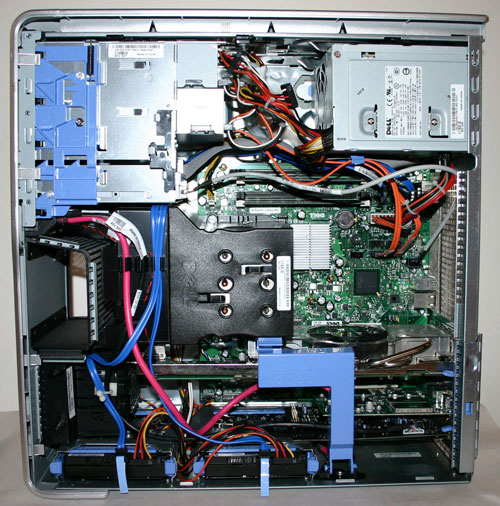 |
| Click to enlarge |
We were given a high-end configuration, complete with almost every accessory that most people would want. This has an interesting impact on the interior appearance, as you basically have a wide open middle section while the top and bottom of the case are more packed with components. The wiring isn't absolutely pristine like you might see in some of the higher end system integrator offerings, but most of the wires are secured at various points to keep them out of the way. Without a case window, we aren't too concerned about a few unsightly wires, and there's still plenty of open space allowing for ample air flow to keep your system interior cool.
 |
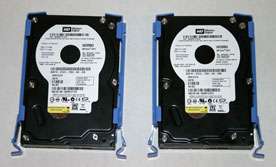 |
| Click to enlarge | |
At the bottom of the case are the two internal 3.5" drive bays, which are both occupied by 320GB 16MB cache Western Digital drives in our system. Both drives reside in plastic sleds that can be easily removed, but the drives themselves are secured to the sleds with standard screws. Dell set up our drives in a RAID 1 configuration, which will help protect users from data loss and downtime due to a failed hard drive. RAID 1 is not generally considered a backup solution, as it doesn't protect you from accidentally deleted files, viruses, or data corruption issues that might occur, but as a means of improving uptime it is definitely useful. If you need more storage capacity, you can opt for larger drives and/or omit the RAID 1 configuration (or perhaps go with RAID 0 for enhanced performance at the cost of reliability). If you want to add more than two hard drives, you could use the 3.5" or 5.25" external bays (with an adapter for the 5.25" bays).
The 375W power supply had no problems running our test configuration, which is basically loaded up with most of the high-end features you might want to add. A third or fourth hard drive would use a bit more power, as would larger drives, but even if you filled every available expansion slot it would be difficult to overload the power supply with current components. The story might change in the future with the release of the next-generation video cards from NVIDIA and ATI, unfortunately, so in the long term the PSU may prove insufficient. Most people don't generally buy Dell computers for their extensive upgrade capability, so this probably isn't a major concern for them. On the other hand, those who might want a G80 or R600 could very likely find themselves in need of a higher performance PSU.
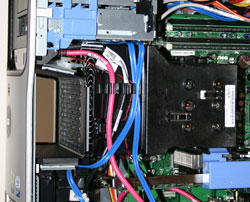 |
| Click to enlarge |
That brings up another point that's important to mention. In the past, Dell has been somewhat notorious for including proprietary power connectors and motherboard designs. Starting about a year ago, all motherboards should now be using a standard 24-pin ATX power connector with an additional 4-pin ATX 12V connector. It was possible to get adapters in the past that would allow the use of a generic power supply, but this is now unnecessary. If you decide that you want something better than the standard 375W power supply in the future, it should not be at all difficult to replace the power supply. It would still be better to get a higher capacity power supply in the first place, especially given the price of the system, but as stated the 375W power supply should be sufficient for the vast majority of users.
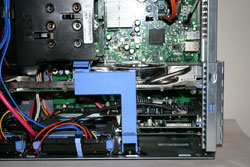 |
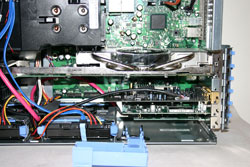 |
| Click to enlarge | |
We spoke earlier about the expansion card slots and the tool-less mechanism that is used to secure them. You can see a close-up shot of this area in the above pictures. First, you have the main blue latch that helps hold all of the expansion cards in place, and it also provides for some cable routing. This latch snaps into the bottom of the CPU heatsink duct. At the back of the case, you have a hinged clamp that holds all of the expansion brackets in place, and there are slight protrusions that slip into the screw notches in order to fully secure the cards. Opening the hinge is accomplished by pressing the two small "buttons" and then the whole door swings open. The whole system is extremely slick, and we would really like to see something similar make its way into standard ATX cases. It's almost a shame that most people that purchase an XPS 410 are unlikely to appreciate the ease with which the system can be upgraded.
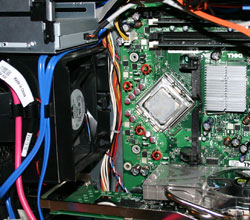 |
 |
| Click to enlarge | |
It is extremely easy to access all the components within the XPS 410. The most difficult component to replace is the CPU, and event that task is relatively simple. Two screws are used to secure the plastic duct that also holds the heatsink in place. Loosen those two screws, gently pull back on the CPU duct, and it should come loose giving access to the CPU socket. While the Dell heatsink isn't the largest we have seen, considering that there are no overclocking options on the system and that Dell doesn't ship the XPS 410 with the X6800 processor and the cooling solution should be more than sufficient. Future upgrades to quad core CPUs should also work, provided Dell releases an appropriate BIOS update.
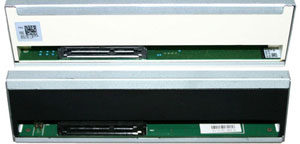 |
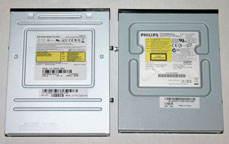 |
| Click to enlarge | |
One item of interest is the optical drives that Dell includes. The system is entirely legacy free, which means there are no PS/2 ports, no serial ports, no parallel port, and with the use of the ICH8 Southbridge, there are no IDE ports either. There are six SATA ports, four of which are occupied in our configuration. Two of these are used for hard drives, while the other two are used for the optical drives. Dell includes a Toshiba TS-H553 16X DVD-RW for burning/backup duties, while a Philips DVD-ROM (a rebranded BenQ) serves as a second optical drive. Extensive testing of the DVD burner capabilities is beyond the scope of a system review, but we were able to burn and read a couple DVDs without issue. Both optical drives are average in terms of noise levels, which means at maximum speed they are actually louder than anything else inside the system. Luckily, optical drives don't need to run continuously. Unfortunately, SATA optical drives currently cost more than IDE optical drives, which likely adds an extra $50 or so to the system price.
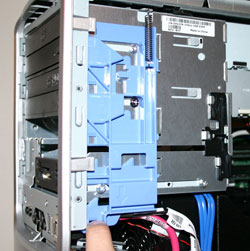 |
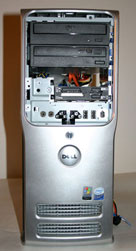 |
| Click to enlarge | |
Accessing the drive bays is once again an exercise in convenience. All you have to do is press down on the blue locking mechanism, and that will release the front cover and allow you to slide out any of the drives. The drives use screws as a sort of mounting rail, so if you want to replace a drive you will have to break out a screwdriver, but if you just need to temporarily remove the drives the process is very simple.










50 Comments
View All Comments
Gary Key - Monday, September 18, 2006 - link
BF2 is just a bit weird with the benchmark results. Although our demo contains several minutes of intense action on the Daqing Oilfield map in a variety of vehicles and personnel assignments we typically find there is very little difference in the benchmarks between 1600x1200/1680x1050 or 1920x1200/1920x1440 resolutions with a decent video card. Also, with the latest video cards like the 7900GTX or X1900 there is no penalty now for 4xAA at 1280x1024 as an example. The benchmark will score the same as we are not GPU limited at that resolution with the Dell configuration as an example.
JarredWalton - Monday, September 18, 2006 - link
BF2 also doesn't properly support WS formats except in demo playback. Go figure. So perhaps it isn't properly optimized for aspect ratios other than 1.333 (the standard for 4:3 displays).giantpandaman2 - Monday, September 18, 2006 - link
Thoroughly enjoyed it. :)Again, only suggestion would be to add how long it took between ordering and receiving.
bamacre - Monday, September 18, 2006 - link
I've been telling everyone how well-designed these cases are, and how powerful the PSU's are. I stuck an X1900 XTX card in a precision 390 with a 375W PSU, and it ran great. People don't understand wattage isn't everything.And, I totally agree, I wish case manufacturers would take a peek and learn a few things from the higher-end Dell cases.
Again, great job on the review.
yyrkoon - Monday, September 18, 2006 - link
Dell cases suck, however thier cases work for thier systems very well. Dell has always(atleast for the last several years) had innovative ways of cooling thier systems, I'm a bit surprised I even saw a radiator in this system, because normally, with a normal heatsink, and thier exaust shroud, thier systems run pretty dahmed cool.Anyhow, if you REALLY think thier cases are great, buy a Lian Li, then think on it again :) All it takes for me to realize it sucks, is to look at the back of the case, and notice how cheap it is.
Dell makes great computers for people who dont want to build thier own systems, however, for those of us who do build our own systems, I think all of us would agree, that nothing is better than a hand built system. You wont, however, be able to beat Dell prices (latest Dell catelog showed thier rock bottom system selling for $399 us, including a 17" LCD !)
mino - Monday, September 18, 2006 - link
For sinle C2D, 2sticks generi DDR2, single X1900XTX, dual HDD and dual optical ANY _properly_designed_ 350W PSU is sufficient.The real issu is, these times 300W != 300W, thats the real issue.
As a fact wattage matters, however the real one, not the written one...
kristof007 - Monday, September 18, 2006 - link
I really enjoyed reading through the review. So I was wondering would you be able to take that supporting piece off the 7900 and snap it onto a gfx card you buy?JarredWalton - Monday, September 18, 2006 - link
The blue plastic is basically made to hold a GPU in place and it should work with any standard GPU. Some specialized cooling solutions won't fit most likely, but I did slot in an X1900XT card and it fit without problems.Homerboy - Monday, September 18, 2006 - link
I'm so sick of the standard, anti-big-box-company rhetoric that's thrown aroung the Anantech Forums. Maybe this will quiet their tone.mino - Monday, September 18, 2006 - link
In the US, Absolutelly True.Here, in Slovakia, Central Europe, NO.
Simply because the smaller the market, the more expensive the Dell and the worse the support.
We buy no pre-built ones since the for a price on an low-end pre-build I can have mid-to-high end custom build.
And local support -if knowledgeable- is FAR more effective and responsive that any DELL's. Not to mention cheaper, since most HW issues are warrantied even on customs. The real problem's are HW-SW and SW and most of these are not warrantied by anybody, so you are gonna solve them by yourself or pay huge sums for paid support.
Here the ~$200 per incident from big players is outrageous. Such can pay me 2-3 days of on-site professional's salary. And I need that professional no matter what.
Those Dell's prices are cute, if one forgets they ask $1000 here for the same machine sold at $500 in US... That puts thing a bit into the perspective.
Also to maintain an stable of a few hundred of those machines >3yrs often becomes a real pain.
Reason being 1GHz/512M Athlon/PIII from 2001 is still pretty sufficient for most of the tasks these days, also budgetary constriants are never predictable...
As of now, I simply buy 30% motherboards above the PC count and I'm pretty nicely covered for 5+yrs. 3yrs is warranty, and after that I have own spare parts stacked up nicely on the self.
Any other part is a comodity thingie, som almost no stockpile needed.
This way we can repair any HW failure within minutes of diagnose and if needed pretty comfortably operate for a few yers under seriosly limited budget.
So for me - screw the Dell's of this world :)